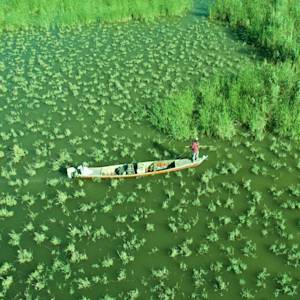Indus River
2023 CE • India and Bangladesh
"More than 200 small islands rise from the jade waters of the Bay of Bengal. Gnarled roots, shrubs and trees stretch across thousands of miles of land and sea. Villagers paddle along waterways in search of crabs and fish. Bengal tigers lurk within dense forests, emerging to swim the narrow channels." The Sundarbans are "a swampy stretch of low-lying islands and coastal forest spanning from the eastern edge of India to southwestern Bangladesh. More than 13 million people call the area home, making their living fishing, shrimping, farming and gathering honey. The region also supports more than 300 types of plants and nearly 700 species of wildlife, including threatened Indian pythons, estuarine crocodiles and Ganges river dolphins . . . . It’s home to the world’s largest contiguous stretch of mangroves, trees and wetlands that survive in brackish water. Mangroves provide timber and food, prevent soil erosion, support marine life, and buffer India’s and Bangladesh’s coasts against storms and tidal waves. But the mangroves are also increasingly threatened. Pressures like population growth and sea level rise are pushing in on the Sundarbans’ forests from all sides . . . Seas are rising twice as fast in the Sundarbans as the global average . . . The situation is poised to worsen. Scientists predict oceans to rise up to 2 meters by 2100 due to climate change." In addition to climate pressures, growing populations in the Sundarbans region threatens the vitality of the ecosystem. People along the river are heavily dependent on forest resources, which has led to degradation of the habitat and loss of biodiversity.
Janet Ranganathan, Sarah Parsons and Jasmine Qin, "Squeezing The Sundarbans: Threats To World’s Largest Mangrove Forest Put Millions Of People At Risk," Resource Watch, May 24, 2018. "Sundarbans: Conservation Challenges," World Wildlife Fund - India.
Image: RokonFaruk, CC BY-SA 4.0, via Wikimedia Commons


Learn about Maya Lin’s fifth and final memorial: a multi-platform science based artwork that presents an ecological history of our world - past, present, and future.

Discover ecological histories and stories of former abundance, loss, and recovery on the map of memory.

Learn how we can reduce our emissions and protect and restore species and habitats – around the world.

See how art can help us rethink the problems we face, and give us hope that each one of us can make a difference.

Help make a global memorial something personal and close to home. Share your stories of the natural world.


